Interior walls were removed from the room’s previous configuration to open up the space and make it sunnier.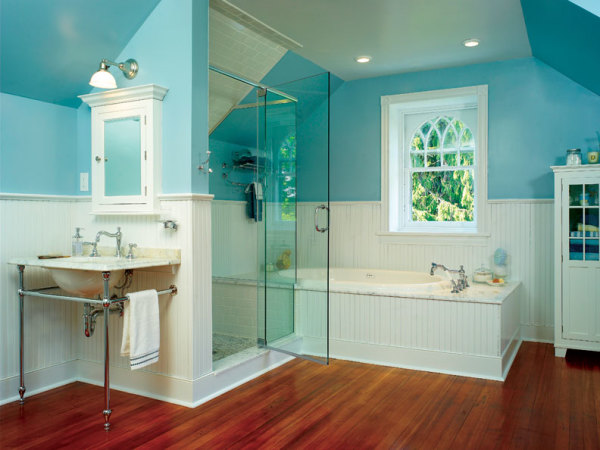
“It was a disaster,” Mary Seelaus freely admits of the 19th-century Colonial Revival home she and her husband, Jere, purchased almost two decades ago. An owner in the 1950s had decimated much of the original character of the house, ripping out built-ins and covering up fireplaces; just before Mary and Jere took over the house, a contractor had abandoned it halfway through another renovation—but not before he removed most of the original plumbing fixtures and replaced them with cheap builder stock. “There wasn’t a whole lot left when we came on the scene,” says Mary.
Still, the couple fell in love with the home’s location in a historic neighborhood in the sleepy Philadelphia suburb of Maple Glen, and were impressed by its pedigree—the home was remodeled to its current Colonial Revival appearance in 1896 by Horace Trumbauer, the prominent Philadelphia architect whose firm designed several high-profile commissions in the city, including the Philadelphia Art Museum.
After the marble sink tops were refinished, they were fitted with new basins, period-style legs, and reproduction fixtures.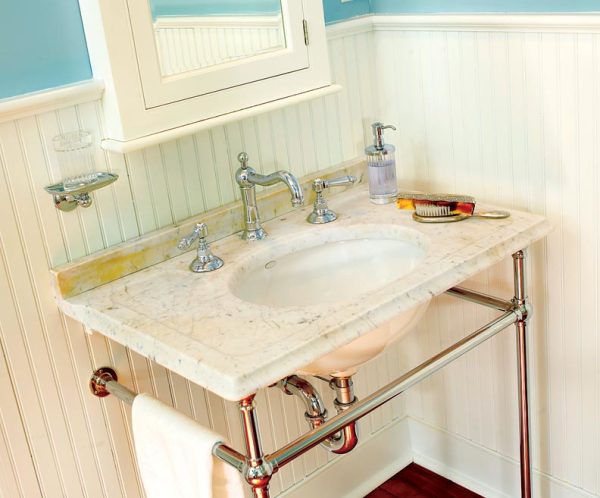
On their initial tour of the house, the Seelauses happened upon a small treasure trove of original items stashed in the basement, including marble slabs that were once part of a shower stall in the master bath, three marble sink tops, and some original floorboards that were taken out when a second-floor bedroom was dismantled to create a two-story foyer. Before they agreed to buy the house, they specified that these items be left in the basement.
As they’ve slowly undertaken the process of putting the house back together, they’ve drawn from the stash several times—marble from the shower stalls was used to fashion a new hearth in the library; the extra floorboards have been used for spot repairs throughout the house. But the sink tops sat idle until two years ago, when Mary and Jere finally tackled what was perhaps the home’s most disastrous room—a third-floor space that had originally served as a bedroom, but had been haphazardly converted into a bathroom by the last owner.
“It was little more than a toilet and a makeshift sink,” says designer Dave Cerami of Home Tech Renovations, a local kitchen-and-bath design firm that specializes in older homes, who worked with the Seelauses on the restoration project. The room had a tub, too, but it was leaking into the master bedroom below. “Our number one goal was making it functional,” says Mary.
Because the marble pieces used for edging on the tub surround were so long and thin, Home Tech embedded them with steel rods to prevent cracking.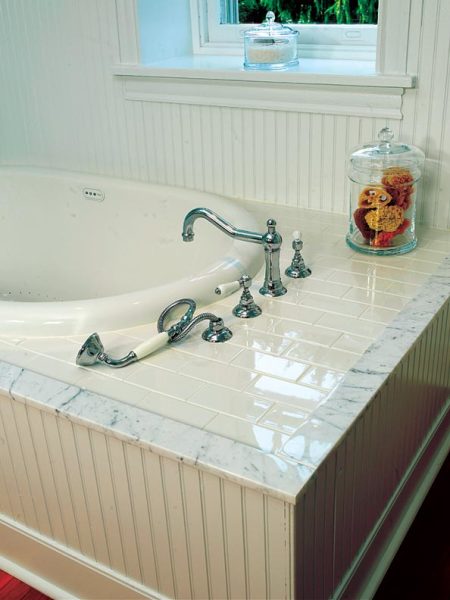
Close behind on the list of priorities was finding a way to reuse the Carrara marble sink tops in the basement. The Home Tech crew selected the best two tops and restored them, using the third to create backsplashes. The restored marble vanities, fitted with new basins and custom-made legs styled after period examples, became the focal point for the revitalized bathroom.
“In talking with previous owners, we found out that the sinks had originally been installed in the 1920s,” says Mary, “so I wanted a bathroom that would have that 1920s feel.”
She rounded out the Jazz Age style with reproduction and salvaged light fixtures turned up during an online search one rainy Sunday. “We were planning to go look at some salvage places in Philadelphia, but I didn’t feel like going out, so I went online to browse instead,” Mary remembers. She stumbled across Massachusetts-based PW Vintage Lighting, where she found a pair of reproduction lights to go over the medicine cabinets, plus an old factory light that had been fitted with an opaque white dome-shaped diffuser. “I’d never seen anything like it before,” Mary says, “but it really worked.”
The bathroom’s distinctive overhead light is a vintage Holophane fixture augmented on the bottom with a dome-shaped diffuser to create what appears to be a cohesive sphere.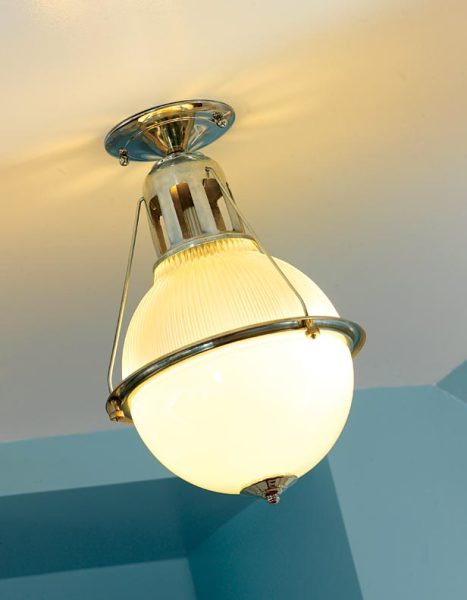
Meanwhile, Dave worked to tie the sinks to other elements in the room, edging the shower stall and the tub’s beadboard surround in carefully matched Carrara marble. “We went through several different slabs of stone to find one that would best mimic the color of the sinks,” he says.
While Mary loved the cottage feel of the beadboard tub enclosure and matching wainscoting, she wasn’t initially sold on the frameless glass shower stall. “I couldn’t visualize it,” she says. “It just sounded so modern that I had a hard time with it.” But Dave, realizing that a solid shower wall would have blocked the flow of light through the room, softened the modern lines by tiling the stall with period-appropriate subway and hexagonal tile, and outfitting the shower with reproduction fixtures.
To warm up the white marble, tile, and beadboard, Mary wanted to keep the room’s original pine floors, which were discovered when carpet and tile installed by the previous owner were pulled up. Most of the original boards were in decent enough shape to be sanded and refinished; in places where they were too damaged to save, they were replaced with the extra floorboards from the basement. The walls were painted an invigorating shade of blue to help bring out the marble’s gray undertones.
“I finally just trusted his expertise,” says Mary, “and I’m glad I did. It is very contemporary, but it makes the room really light and open.”
Designer Dave Cerami of Home Tech Renovations chose Azek beadboard to trim the walls and tub surround for a water-resistant yet period-appropriate aesthetic.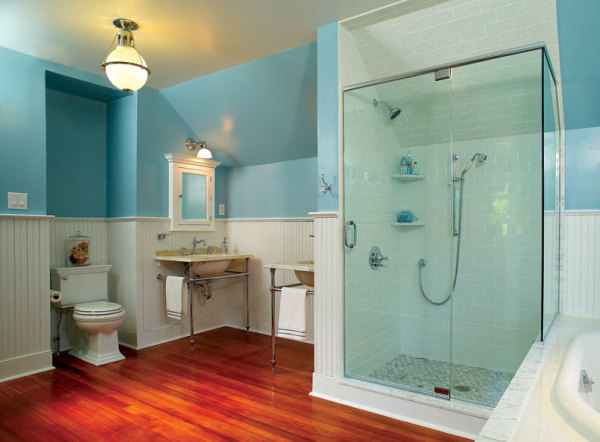
In addition to refreshing the aesthetics of the bathroom, Home Tech also reconfigured the makeshift plumbing, pulling dedicated hot and cold water lines to the third floor to service the bathroom. “There’s nothing worse than waiting for hot water to reach the third floor, or getting out of the shower to find that the room is freezing cold because no one thought about insulation,” Dave says. “We look at what we need to do not only to make the bathroom look good, but also to make it comfortable.”







